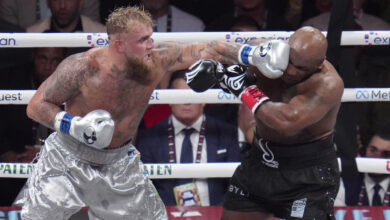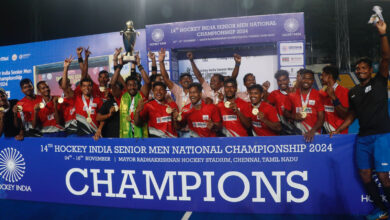Border-Gavaskar series: No longer lead acts, but Virat Kohli and Steve Smith remain central characters for India, Australia

The burning sun above their head, Pat Cummins and Rohit Sharma posed beside the Border-Gavaskar Trophy for the customary pre-series photo shoot. The captains exchanged a hug, handshake and chuckle before they hurriedly escaped the harsh sun. It was exactly how the previous meeting between the two sides in the subcontinent took off, with a warm camaraderie, though the men beside the shimmering trophy were Steve Smith and Virat Kohli. And how the fey and fascinating series ended, with heat and fire, accusations and recriminations, with Kohli quipping that “he would never be friends with Australians.”
In many ways, it was a Kohli-Smith series, their country’s finest batsmen, indomitable leaders, inscrutable figureheads, their teams stoked and forged in their ideals, two superstars locked in a relentless arm-wrestle for glory, each unbudging and unflappable. It was touted, and with sufficient realism, that this was the first of their several generation-defining bouts between them. Like Shane Warne and Sachin Tendulkar, like Rafael Nadal and Roger Federer. Most eras had just one titanic captain, here there were two, equals and competitors in an insatiable quest to out-do, out-score and out-captain each other, in the middle of something extraordinary, performing in a plateau beyond the reach of any other player.
But the lines of destiny rebelled, as their lives and careers would traverse through dark and narrow alleyways before they would reunite under the searing Nagpur sun.
Lights 💡Camera 📷Action ⏳
🎥 Snippets from #TeamIndia’s headshots session ahead of the #INDvAUS Test series! 👌 👌 pic.twitter.com/sQ6QIxSLjm
— BCCI (@BCCI) February 7, 2023
That different men were posing with the customary photo shoot with the trophy is symbolic of the destiny that drifted them apart. A few months after the 2017 series, after Smith leapt further into Baggy Green immortality with a thumping Ashes win, he was stripped of the captaincy in the wake of the sandpaper-gate incident and banned for a year.
Against a Smith-less Australia, Kohli scaled the peak of his captaincy stint when he became the first Indian captain to win a series Down Under. But two years later, Kohli relinquished captaincy in the middle of a gripping spell of depression, when runs and centuries had dried up and when he began to un-love the game he had so loved.
This divergence from the linearly preconceived career paths makes their narratives all the more arresting, the vulnerability of the champion athletes, the human side that twinkles from beneath the veneer of athletic invincibility. Like Federer’s tears, Messi’s tirade against Barcelona in his hour of departure.
A lot has changed. Both teams have a more mellowed approach on the field, more cricket-centric and the so-called spirit-of-the-game driven. It’s inconceivable to think that either side has fired a verbal salvo yet (though there is ample time). Kohli is no longer the absolute batting mainstay in his team, though he will still be the most feared. For, such is his aura and the glitter of his work. Similarly, Australia is no longer dependent on Smith alone for piling runs in the subcontinent, yet it would be his wicket that India’s bowlers would value the most, and the one Australia would bank on to end their nearly two-decade pangs.
Yet, no matter how their career has unfolded, it’s their shadows that would cast the longest in the series. No matter the result or the runs, the throbbing narrative would centre around them, the hundreds they made and they did not, the matches they defined and did not. They are like two thespian actors, whose brightest days seem over, but when holding the stage their light obscures all others. The audience hypnotically gravitates to them in the faith that there is a final sparkle before they fizzle into the sunset, waiting for them to redefine themselves, as champions do. They do not lose; they regroup and find their way back even in pitch darkness.
At their best, there was a sense of genuine ultimacy, of sport as good as sport gets. Smith has already rekindled some of his lost fire. Though he has never rescaled the peaks of 2017 or 2015, he has been consently scoring runs. A 145 not out in Galle, a 200 against West Indies in Perth and 104 against South Africa in Sydney all point to his inevitable reacquainting with form, but without strumming the high notes of consency or conversion rates. “I think I can say that I am close to reaching the form I showed in the previous tour here. I have been in good head space and getting into good positions when batting in the nets,” he said in a press conference.
Eager would be Kohli to dust up his hundred-hitting ways. It’s his longest century drought in this format—36 innings. Never in his long-form career has his form scrutinised so brutally, seldom has his spot looked as shaky as it had in recent times, rarely has question marks hung over his adeptness to playing spin, as he has averaged just 23.25 in his last 15 innings. There is indeed scope for optimism. Kohli has liberated himself from the vortex of self-doubts that had tormented him, shook off the shackles of the mind, has been scoring hundreds in the shorter formats and more optimically, rediscovered the joie de vivre in batting. Rare are the moments of petulance and moodiness.
Perhaps the slump in form correlated with the indigestible reality that they were no longer captains, the extra responsibility of captaincy being the fuel for the batting too. Smith once admitted too: “I actually think I play better with pressure, that extra pressure when the team needs something more and things like that. My record probably is better when I’m captain than when I’m not. That sort of pressure doesn’t really bother me.”
Kohli has not made a similar admission, but the (alleged) circumstances that led to his resignation could have affected him and rubbed onto his batting. It is perhaps not even an ego thing, but hollowness. Even the toughest athletes are not immune to moments of fragility. The best would come out of that. His former coach Ravi Shastri believes his record against Australia would “spur him on”. “He would be charged up and want to start well. He would be a thorn in the flesh for Aussies,” he recently said.
How Kohli overturns his Test-match fork would be another gripping chapter in his career. For all the plans and practice, tweaking and retuning, often it’s just one spontaneous moment that suddenly transforms form. For Smith, it was a cover drive he executed against Afghanan. “It was probably that ball that I hit through the covers, just my weight transfer through the ball. The way my hands went through it and I’d felt it a little bit in the nets but I hadn’t implemented it in the game yet. So as soon as I hit that shot I was kind of like, I’ve just found something has clicked. It’s the rhythm I’ve been searching for.” Kohli would wait for that moment in Tests—and with him a nation.
But here, Kohli and Smith are no longer the lead acts, yet somehow the central characters, their shadows casting longer than any of their colleagues over the series.







